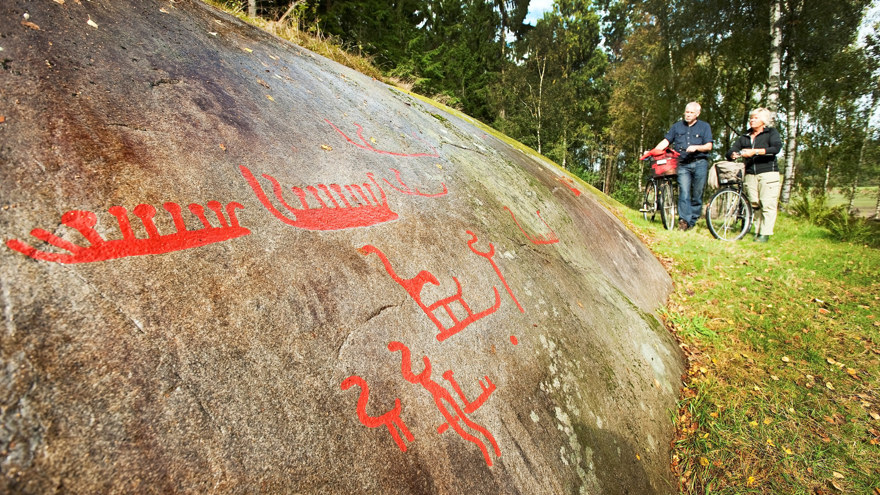World Heritage walks

This is a 6 km path that takes you to three different places with exciting rock carvings: Lövåsen with its shaman, the Gerum panel with the flying swing and Sotetorp with ships full of people doing backward somersaults.
Beside the carvings, which are both painted and unpainted, there are information boards that tell you about the locations and the interpretations of the rock carvings. The tour also takes you past other sights of cultural and historical interest such as livestock paths, a ruined windmill and remains of cottages. Along the way there are a couple of places for a rest and a location affording a magnificent view of the Tanum Plain and the World Heritage Area. From the car park red-topped posts show the way. The path is quite hilly in places.
Kasen Lövåsen
This is the first panel that you reach if you follow the path. On the far side of the panel there are two deeply carved ships, very visible in the afternoon sun. Close beside the platform on the steps there are two other very interesting ships. In both cases the crew can be clearly seen with their paddles raised in the air. In the stern of the ship on the left stands a man who is a good deal bigger than the other men of the crew. Perhaps there is a value perspective and it is the ship’s skipper that we see. From the man’s head what look like rabbit’s ears stick up. We are presumably looking at a helmet with horns. It was during the Bronze Age that horned helmets were fashionable and not during the Viking era.
Ten metres or so to the right of the steps there is another man with a horned helmet. This is the “sorcerer” or “shaman”. Like the skipper the shaman has what appears to be a big nose. These elongated faces have been interpreted as indicating that the person depicted is wearing a mask, perhaps a bird mask with a beak. The shaman is also interesting because he shows some of the most common attributes that can be seen on the men of the rock carvings. That it is a man can hardly be doubted because the shaman is depicted with a clearly erect penis. The scabbard of a sword protrudes from the rear of the shaman. The end of the scabbard is in a form similar to the bronze fittings that have been found from the Bronze Age. The extremely thick calves are also something often seen on persons depicted. Perhaps they were regarded as handsome.
The Gerum Panel
The Gerum panel, also known as the Runohällen (the runic panel), bears no runic script, only Bronze Age carvings. The name comes from the fact that in times past what could be seen on it was believed to be prehistoric script. In the middle of the Runohällen is its most frequently discussed carving, the flying swing or the maypole. The image has acquired this name because it brings to mind the maypoles and dancers that can be seen in, for example, Dalarna. At the top there is a platform with a man on it. From the platform hang “ropes” with figures on the ends.
However it is not only this unique carving that makes the panel interesting, but also its place in the landscape. Runohällen is a carving that is located very low. Sea level during the Bronze Age was much higher than it is today, and at the beginning of the Bronze Age, around 1800 B.C., the whole rock was under water and the cultivated landscape where the panel lies today was a part of the inner archipelago. By about 1500 B.C. the sea had receded a little and the shoreline was about half a metre below the platform of the maypole. It was at this time that the first images were carved on the panel. The earliest images are the ships that have a keel line that goes up like an antenna at one end and finishes in a blob at the other. The ships have thus been carved on a panel that was lashed by the waves of the Bronze Age and it is not difficult to imagine a clear connection between the depictions of ships and the sea beside which they lay.
Sotetorp
Sotetorp is the third and final rock carving on the “World Heritage Tour” circuit. The best known carving on this rock is probably the representation off an acrobat, a “voltigeur”, who is doing a backward somersault over a ship. Men resembling the shaman from Kasen Lövåsen are standing in both the bow and the stern. Several experts have drawn parallels between our Scandinavian acrobats and the depictions of bull leapers from the contemporary Minoan culture of Crete.
There have also been discoveries of acrobats of bronze that have presumably been attached to wooden models of ships. Just to the left of the ship with the voltigeur there is a so called sunwheel, a symbol normally taken to represent the sun. It could of course also be a depiction of a wagon wheel and spokes, a new invention during the Bronze Age.
Visit World Heritage walks website






